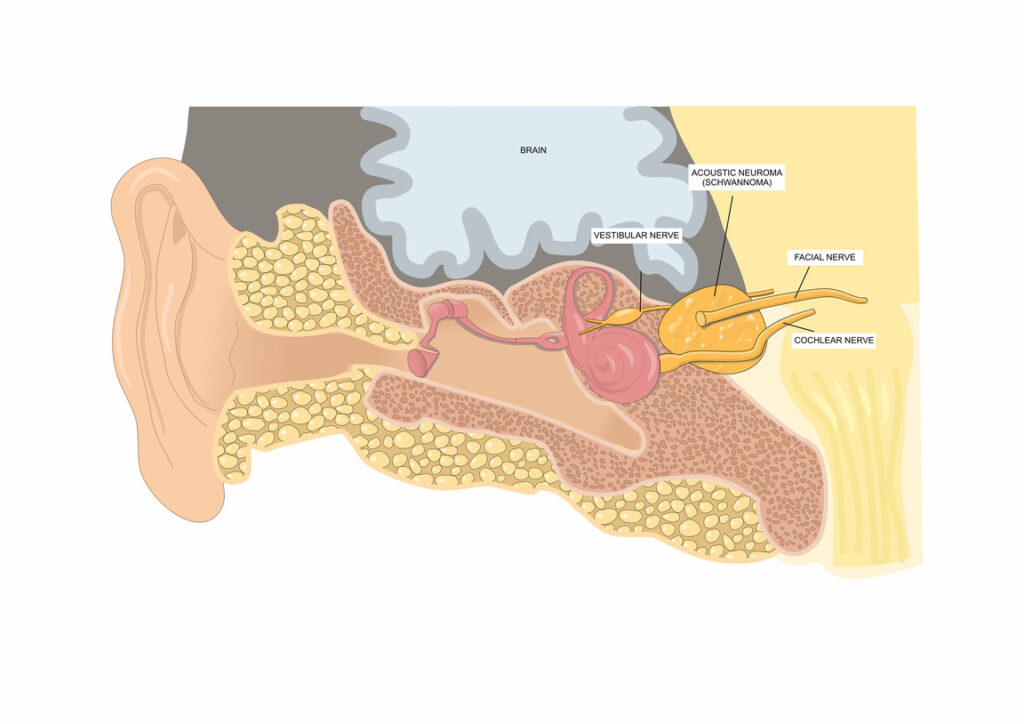What is acoustic neuroma
Acoustic neuroma, also known as vestibular schwannoma, is a rare non-cancerous, slow-growing tumour that develops on the vestibular, the main nerve leading from your inner ear to your brain. Divisions of this nerve play a vital role in both hearing and balance, so pressure from the tumour can cause hearing loss and instability.

Types of acoustic neuromas
Sporadic, unilateral acoustic neuroma
These neuromas affect 95% of all patients. They grow on one side of the body and arise from sudden, non-hereditary mutations. Sporadic neuromas typically affect adults between the ages of 30 and 60.
Genetic, bilateral acoustic neuromas
Genetic acoustic neuromas grow on both sides of the body. They occur in people with the genetic disorder neurofibromatosis type 2, a mutation in chromosome 22 that affects the gene responsible for the production of Schwann cells.
Signs and symptoms
Individuals with small tumours are usually asymptomatic, but even then, the severity of the symptoms depends on the tumour’s location. Also, since acoustic neuromas are slow-growing, symptoms develop gradually and usually include:
• Hearing loss in one ear
• Ringing in the ear (tinnitus)
• The sensation that you’re moving or spinning (vertigo)
• Persistent headaches
• Blurred or double vision
• Pain or numbness on one side of the face
• Limb co-ordination problems on one side
• Voice hoarseness and difficulty in swallowing
Although rare, acoustic neuromas can grow big enough to compress the brainstem. They can also cause the build up of fluid in the brain, which can be fatal.
Causes of acoustic neuroma
Over 90% of acoustic neuromas occur without any specific cause. There are also no particular risk factors for the development of these tumours. That said, exposure to radiation to the head and neck area and prolonged exposure to loud noises have been studied as potential risk factors for acoustic neuroma.
In a small subset of cases, acoustic neuromas are caused by a rare hereditary disorder known as neurofibromatosis type 2. Acoustic neuromas caused by this disorder usually affect both ears.
Diagnosis
Acoustic neuroma can be difficult to diagnose, especially in the early stages, because the symptoms develop slowly and are easy to miss. Common symptoms like hearing loss are also associated with many inner and middle ear problems, making it harder to diagnose acoustic neuroma.
Talk to your doctor if you are experiencing any of the mentioned symptoms. They will conduct a few tests, including:
Hearing test
A hearing test or audiometry is conducted by an audiologist to measure how well you hear sounds and speech. The doctor will ask you to listen to different sounds and speech while wearing earphones attached to a machine that measures hearing function. Each tone is repeated at faint levels, and the doctor asks you to indicate each time you hear the sound.
Imaging scans of the head
Magnetic resonance imaging (MRI) is also used to diagnose acoustic neuroma. An MRI scan uses strong magnetic fields and radio waves and can detect tumours as small as 1 to 2 millimetres in diameter. If an MRI scan isn’t available, a CT scan may be used. It uses a series of X-rays to create a detailed image of your head.
Treatments for acoustic neuromas
There are several treatment options for acoustic neuroma. However, your treatment plan depends on the size and position of the tumour, your general health, and how fast it’s growing. Let’s look at the available options:
1. Monitoring
If you have a small tumour that is growing slowly and causes minimal symptoms, your doctor may decide to monitor it with regular MRI scans to determine whether the tumour is growing and how quickly. Monitoring is usually recommended for older adults who may not be good candidates for an aggressive treatment plan.
2. Surgery
Surgery is recommended in three scenarios:
• When the tumour is very large
• If you are experiencing symptoms
• When the tumour continues to grow
The goal of the surgery is to remove the tumour, preserve the facial nerve, and prevent facial paralysis. Given the risks involved with brain surgery, it may be impossible to remove the entire tumour. Any pieces of the tumour that remain after the surgery are treated with a precise beam of radiation to stop them from getting any bigger.
If you present any of the mentioned symptoms and are concerned that you may have an acoustic neuroma, book an appointment with us today for expert investigation and diagnosis.
